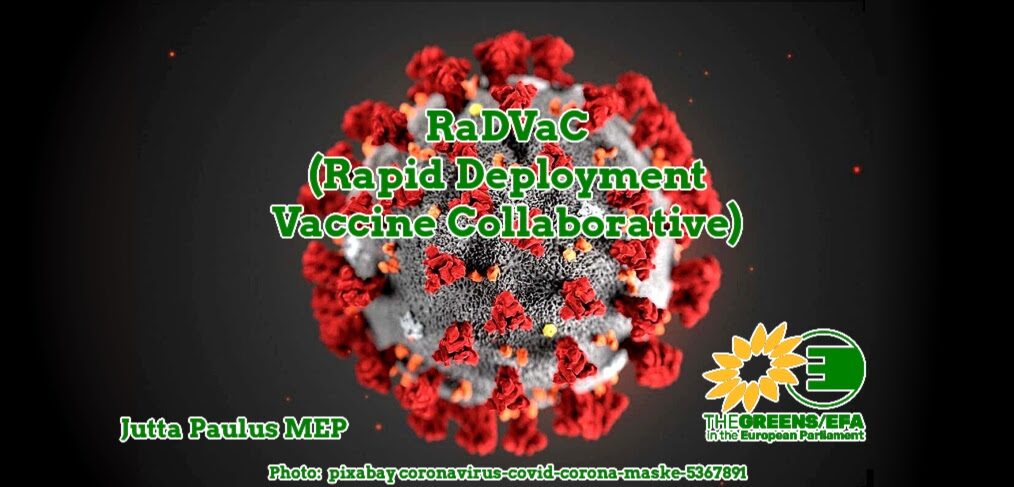
RaDVaC (Rapid Deployment Vaccine Collaborative)
RaDVaC – Explained
RaDVaC (Rapid Deployment Vaccine Collaborative) is an open-source research project for vaccine development project. It is supported by experts from biochemistry and virology, mostly from the university sector – no company is involved. All information can be accessed online; they are under a “creative commons” license for the common good and can be used by anyone.
The vaccine is based on oligopeptides, i.e. fragments of virus proteins that are not infectious themselves, but trigger an immune response directly in the nasal mucosa. The peptides used can be quickly adapted to new virus variants. Application is done using chitosan nanoparticles, which also serve as an immune stimulant. Chitosan is extracted from chitin, the main component of insect and crustacean shells and has long been used for medicinal purposes. Intranasal administration of chitosan-based vaccines has shown mild side effects and high efficacy of both mucosal and systemic immunity when administered in a prime-boost regimen (in both animal models and human volunteer examinations). The RaDVaC vaccine itself has not yet been tested in clinical studies. When used repeatedly over several months by more than 100 self-experimenters, no COVID19 infection was observed, and the most severe complications reported by some participants were a stuffy nose and a headaches.
Advantages of the RaDVaC vaccine
The RaDVaC vaccine has four main advantages.
- Complementary usage to other vaccines possible, improving protection against infection
- Low risk of side effects, as only very small protein particles are applied locally, while other vaccines introduce larger virus units into the bloodstream
- Nasal vaccination can also induce a mucosal immune response at the site of viral infection. It is thus more likely to prevent infection. Injectable vaccines do not necessarily induce mucosal immunity and therefore do not always prevent infection.
- Initial findings suggest that a potent T-cell immune response is triggered. That would mean long-term vaccination protection.
Potential difficulties connected to the RaDVaC vaccine
Until now, safety of self-administration and efficacy have not been systematically tested. Nasal vaccines have been shown to be generally very safe in previous studies, but safety cannot be guaranteed.
Assessing the protective immune response is challenging, especially with nasal vaccines. The vaccine is designed to elicit a mucosal immune response at the primary entry sites of the virus into the body (nose and lungs). So far, positive indications are measurable but still need to be confirmed.
Another problem could be that antibody tests may not show efficacy. This is because intranasal vaccines can elicit different kinds of immune responses. Although a robust and highly protective mucosal immune response will be produced, no pronounced antibody response in the blood might be measurable. Generally, an adaptive immune response is based on humoral immunity (mediated by B-cells and antibodies) and/or cellular immunity (mediated by T-cells). Measuring T-cell immunity to a specific virus is much more difficult than measuring antibody concentration and can only be performed in specialised laboratories. This problem concerns injected vaccines in the same way as nasal vaccines.
Up to now, no clinical trial has been performed. Only the scientists themselves and their sphere have been undertaking self-. To conclusively assess safety and efficacy, clinical trials are of course essential. Due to the open-source principle, finding a sponsor for these trials is difficult. Manufacturer are only willing to pay for clinical trials if they hold patents for the medical product. I asked the European Commission whether the HERA incubator includes a possibility to fund clinical studies for open-source vaccines like RaDVaC and others when there is no commercial interest, because the products are licensed under creative commons or if such a programme is already ongoing. The answer: generally, this is possible, but we need an official sponsor.
Additionally, I had an exchange with the European Medicines Agency EMA about this topic, with a similar response: they are open for this concept, but would need an official application for approval and market authorisation.
I will now seek contact with NGOs to explore our options for joint action towards this cause.
